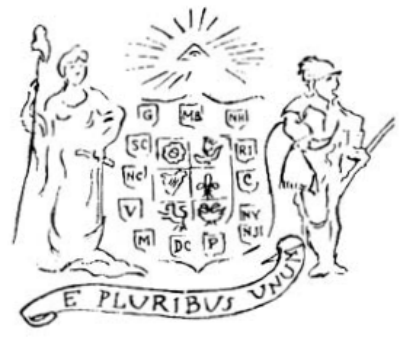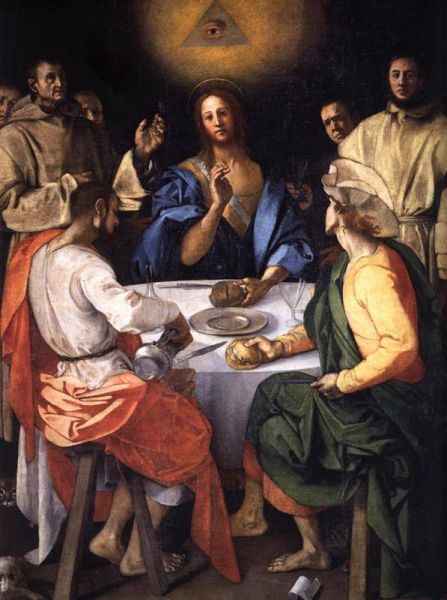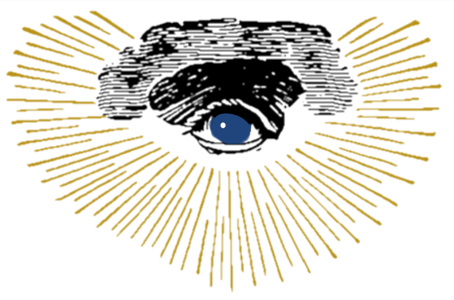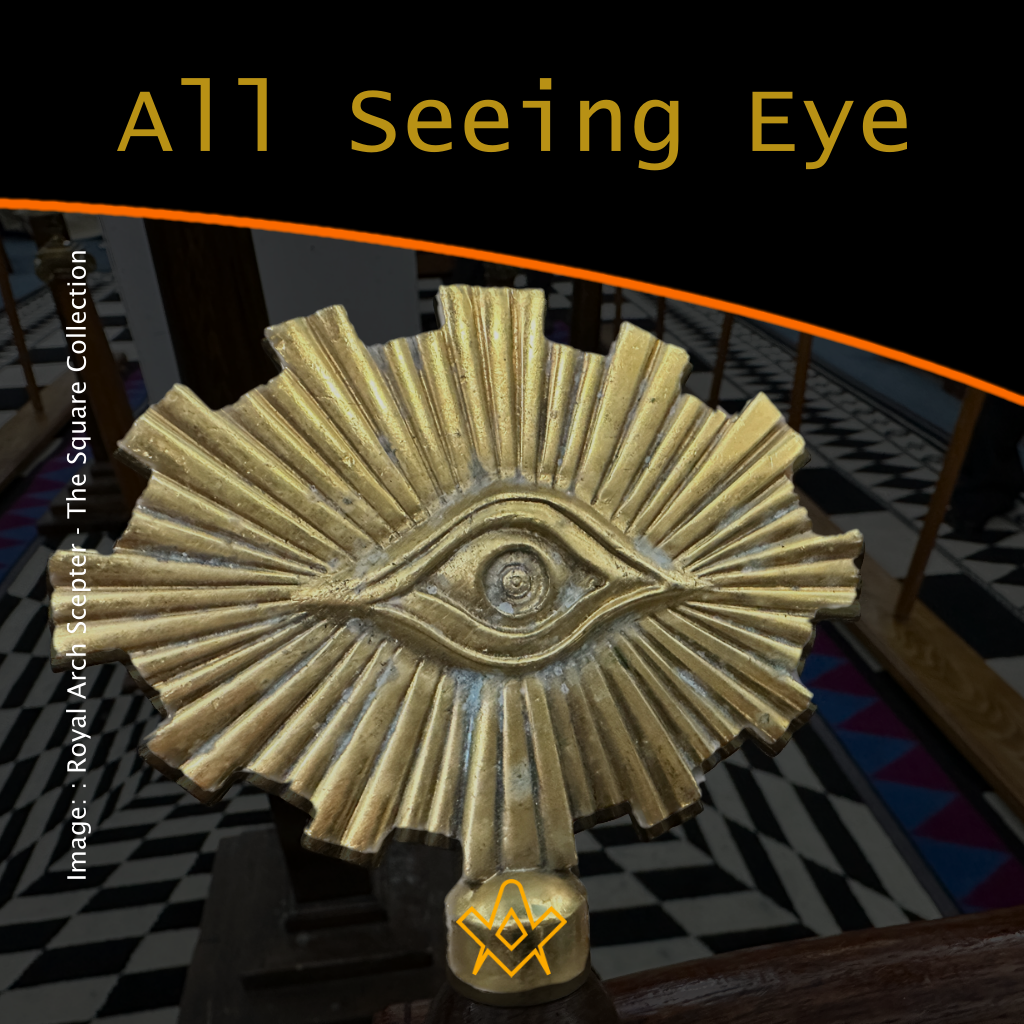The All-Seeing Eye of God, also known as the Eye of Providence, is a representation of the divine providence in which the eye of God watches over humanity.
It frequently portrays an eye that is enclosed in a triangle and surrounded by rays of light or splendour.
Given its widespread recognition as a symbol, the Eye of Providence has significance in the study of iconography and semiotics.
The reverse of the Great Seal of the United States, which is shown on the one-dollar bill, features this well-known illustration.

Original design for the Great Seal of the United States by Pierre Simitiere
IMAGE LINKED: wikimedia Attribution 4.0 International (CC BY 4.0)
The Eye of Providence was included in the symbolism used on the back of the United States Great Seal in 1782.
It is said to have been the idea of the artistic consultant, Pierre Eugene du Simitiere, and at the time was a traditional emblem for God’s beneficent supervision.
It was first presented as a part of the Great Seal by the first of three design committees in 1776.
Du Simitiere represented each of the original thirteen states of the Union by placing the Eye above shields in his initial submission to the committee.
The Eye is positioned above a thirteen-step incomplete pyramid (again representing the founding States but also including the nation’s potential for future growth) on the seal that would ultimately be authorised.
The motto “Annuit cœptis”, which translates to “He approves [our] undertakings,” (or “has approved”) that appears above the Eye provides an explanation for this symbology .
Christianity

Supper at Emmaus by Jacopo Pontormo – (Pontormo, Cena in Emmaus)
IMAGE LINKED: wikimedia Attribution 4.0 International (CC BY 4.0)
Christianity uses the image of an eye to symbolise the idea of divine providence. The Eye, which was enclosed in a triangle in late Renaissance European imagery, was a clear representation of the Christian Holy Trinity.
In Pontormo’s Supper at Emmaus from 1525, the Eye of Providence was later painted atop a representation of three faces.
The Eye is occasionally shown in the seventeenth century as being encircled by clouds or sunbursts.
Church architecture and Christian art still use the Eye of God in a triangle to represent the Trinity, God’s omnipresence, and divine providence.
Freemasonry
The Eye of Providence, which is frequently linked with Freemasonry today, originally appeared in 1797 with the publication of Thomas Smith Webb’s The Freemason’s Monitor and became a staple of Freemason iconography.
In this application, the Eye, symbolising the all-seeing eye of God, serves as a reminder that God, who is referred to in Masonry as the Great Architect of the Universe, is always aware of humankind’s thoughts and acts.
The Masonic Eye of Providence frequently has a semi-circular splendour beneath it and is occasionally encircled by a triangle.
The idea that the Eye of Providence depicted atop an incomplete pyramid on the United States’ Great Seal proves that Freemasonry played a role in the country’s formation is a common one among conspiracy theorists.
The Eye was first used in Masonry 14 years after the Great Seal was made, though.
Benjamin Franklin was the lone Mason among the individuals who served on the numerous design committees for the Great Seal, and his suggestions for the seal were rejected.
Likewise, a number of Masonic groups have categorically denied having any involvement in the Seal’s development.

The All-Seeing Eye
Mackey had the support of the Masonic students of his generation at the time (about 1870) and saw the All-Seeing Eye as a representation of God’s omniscience.
It is unlikely that that interpretation can be supported by Masonic history, but it is undeniably sound in the sense that it represents the logical endpoint toward which any other plausible interpretation may be pursued.
The symbol (and it is a symbol!) is almost completely unknown; it was never the subject of the studies on which this Supplement is based, and if any researcher has discovered any reliable information about the symbol’s origin, it must be buried in a book that is significantly more obscure than the average.
Several factors based on previously published information shed some light on the issue:
1.
Lodges were small, friendly, and worked while seated around their dining table during the lengthy period of the Ritual’s formation from approximately 1717 to approximately 1770.
They were serious and reverent, and the vast majority of Masons belonged to a church, but they were neither theological nor mystical, and they instinctively shrank from anything that bordered too closely upon the province of the Church.
Since those Lodges tended to shy away from theology, it is wise to interpret symbols on their tracing boards without first presuming a theological connotation.
Prior to 1717, Freemasonry retreated even further from it. They were a brotherhood or fraternity carrying on the building trade’s traditions, and they were never aware of their place in religious tradition.
Since they are characteristics of man by nature and are present everywhere, solemnity, seriousness, symbolism, and ritualism are not indicative of religion.
It does not follow that the early Speculative Masons utilised the All-Seeing Eye as a religious symbol, even though it is one of the symbols used in religion.
2.
The All-Seeing Eye might have represented the Omniscience of God. Additionally, it may have represented any one or more of the other five or six truths or concepts.
According to Shakespeare and other writers, it may have originally meant the sun because it rose at dawn.
It may have referred to the Grand Master or the Worshipful Master and served as a reminder that, wherever a man may be and whatever he may be doing, the Craft is keeping an eye on him since he is still a Mason.
Alternatively, it could have been the Tracing Board portrayal of the Blazing Star in the Tessellated Pavement, in which case it would have represented the sun, or day-star, which shines continuously day and night.
It could also have stood for enlightenment, wisdom, and intellect. (Note: Because the day begins before the sun appears and continues after it has set, most folks could not perceive any required relationship between daylight and the sun until modern astronomy made a number of its complex truths familiar to everyone.)
In addition to the omnisciences known to theology and metaphysics, there are many others, such as the omniscience of the law, the omniscience of the government, which keeps an eye on every citizen, etc. Just because the first Freemasons had a symbol for omniscience does not necessarily mean that they meant the Divine Omniscience.
3.
It does not follow that their emblem, if it represented the Divine Omniscience, would have been depressing to them, as if it were only there to prepare them for the last Judgment Day.
Omniscience may inspect a person in order to reward them for virtues they have attempted to conceal rather than condemn them for faults they have committed.
Another symbol that should not have a sombre meaning is the sword pointing at the naked heart. Instead, it should have a joyous meaning because when justice finds out everyone’s heart, it signifies that people have security, live in civil order, and can therefore be happy.
We could use the All-Seeing Eye as a representation of the Divine Omniscience and at the same time, we could use it to represent the Fraternity’s own omniscience (the word need not be defined as absolutely as many think it should) in the sense that it never loses sight of a man once he joins, even if he doesn’t go to Lodge, is confined at home due to illness or an accident, or has moved away.
Sources:
ENCYCLOPEDIA OF FREEMASONRY AND ITS KINDRED SCIENCES
by ALBERT C. MACKEY M. D.
http://www.phoenixmasonry.org/mackeys_encyclopedia/a.htm
Wikipedia contributors, “Eye of Providence,” Wikipedia, The Free Encyclopedia, https://en.wikipedia.org/w/index.php?title=Eye_of_Providence&oldid=1133620271 (accessed January 24, 2023).
Recent Articles: symbolism
 Legends and Symbols in Masonic Instruction Explore the significance of Masonic legends and symbols in this insightful post. Discover how Freemasonry imparts wisdom through allegorical narratives and emblematic imagery, revealing profound moral and philosophical lessons. Unveil the deep connections between Masonic teachings and the broader quest for understanding life’s fundamental questions. |
 Discover the mystical significance of the number 33. From its mathematical marvels and artistic influence in numerology to its esteemed place in Freemasonry, delve into the history and power of this master number. Explore why 33 holds such profound meaning in various spiritual and philosophical traditions. |
 The Practice of Freemasonry - P1 Embark on a transformative journey with Freemasonry, where the exploration of your Center unlocks the Perfect Ashlar within. Through the practices of Brotherly Love, Relief, Truth, and Cardinal Virtues, discover a path of enlightenment and self-improvement. Embrace the universal creed that binds us in the pursuit of our true essence. |
 Discover the fascinating history and significance of the Warrant of Constitution within Freemasonry. Unveil the evolution of this crucial authorization, its role in legitimizing Lodges, and its lasting impact on the global brotherhood of Freemasons. Explore the intricate link it provides between tradition and modern practice. |
 Freemasonry: Unravelling the Complexity of an Influential Organization Mysterious and captivating, Freemasonry has piqued the interest of seekers and skeptics alike. With its intricate blend of politics, esotericism, science, and religion, this enigmatic organization has left an indelible mark on society. Prepare to delve into the secrets of Freemasonry and unlock its hidden depths. |
 Unlocking the Mysteries of Freemasonry: In the hallowed halls of Freemasonry, a powerful symbol lies at the heart of ancient rituals and teachings—the Volume of the Sacred Law. This sacred book not only guides the spiritual and moral journey of Freemasons but also serves as a beacon of universal wisdom and enlightenment. |
 The Ancient Liberal Arts in Freemasonry Embark on a journey of self-improvement and wisdom with Freemasonry's guiding principles. Ascend the winding stairs of moral cultivation, analytical reasoning, and philosophical understanding. Embrace arithmetic's mystical properties and geometry's universal truths. Let the harmony of the universe inspire unity and growth. Discover the profound, hidden knowledge in Freemasonry's path to enlightenment. |
 Initiation rituals around the world are filled with fascinating elements and different images. One of them is that of darkness. When societies speak of darkness, they often mean a lack of knowledge, a lack of choice, or a symbol of evil. During initiation rituals, darkness is used to represent the initiate's lack of knowledge about the world, society, and initiation in general. It can also represent the initiate's inability to make a choice or endure a situation. Whether you have participated in an initiation rite or not, the meaning of darkness remains an intriguing concept worth exploring. Initiation rituals around the world are filled with fascinating elements and different images. One of them is that of darkness. When societies speak of darkness, they often mean a lack of knowledge, a lack of choice, or a symbol of evil. During initiation rituals, darkness is used to represent the initiate's lack of knowledge about the world, society, and initiation in general. It can also represent the initiate's inability to make a choice or endure a situation. Whether you have participated in an initiation rite or not, the meaning of darkness remains an intriguing concept worth exploring. |
 Masonic Deacon rods potentially trace their origins to Greek antiquity, symbolically linked to Hermes' caduceus. As Hermes bridged gods and mortals with messages, so do Masonic Deacons within the lodge, reinforcing their roles through ancient emblems. This connection underscores a profound narrative, weaving the fabric of Masonic rites with the threads of mythological heritage, suggesting the rods are not mere tools but bearers of deeper, sacred meanings that resonate with the guardianship and communicative essence of their divine counterpart, Hermes, reflecting a timeless lineage from myth to Masonic tradition. |
 The biblical pillars erected by Solomon at the Temple's porch, hold a profound place in history. These brass behemoths are not mere decorations; they are symbols of strength, establishment, and divine guidance. Explore their fascinating construction, dimensions, and the deep meanings they carry in both biblical and Masonic contexts. |
 Unlocking the Mind's Potential: Dive deep into ground breaking research revealing how simple daily habits can supercharge cognitive abilities. Discover the untapped power within and redefine your limits. Join us on this enlightening journey and transform your world! |
 Dive deep into the symbolic importance of the trowel in Masonry, representing unity and brotherly love. From its historical roots in operative masonry to its significance in speculative masonry, this article explores the trowel's multifaceted role. Discover its connection to the sword, the story of Nehemiah, and the Society of the Trowel in Renaissance Florence. Unravel the layers of meaning behind this enduring Masonic symbol. |
 Symbolism of The Builder's Jewel Batty Langley's "The Builder’s Jewel" (1741) is a visual masterpiece of Masonic symbolism, showcasing Langley's deep understanding of Freemasonry. The frontispiece highlights key symbols like the three pillars and the legend of Hiram Abiff, emphasizing Langley's dedication to Masonic traditions and teachings. |
 Unveil the mystique of the colour blue in Masonic symbolism. A hue evoking universal friendship and benevolence, its roots span ancient cultures, infusing Freemasonry's core values. This article explores blue's profound significance, guiding Freemasons towards wisdom and spiritual enlightenment. Discover the fascinating journey of this universal symbol. |
 Discover the intriguing world of the plumb in Masonic symbolism with our in-depth analysis. Uncover its rich history, moral teachings, and significance in Freemasonry, guiding members on their path to truth, integrity, and justice. Immerse yourself in the captivating power of this symbol that shapes lives within the brotherhood. |
 Unlock the mysteries of Freemasonry with 'The Key,' a profound Masonic symbol. This seemingly simple instrument holds a deeper meaning, teaching virtues of silence and integrity. Explore its ancient roots, from Sophocles to the mysteries of Isis, and discover how it symbolizes the opening of the heart for judgment. |
 Unlock the secrets of the Freemasonry with The Blazing Star - a symbol that holds immense significance in their rituals and practices. Delve into its history, meaning and role in the different degrees of Freemasonry with expert insights from the Encyclopedia of Freemasonry by Albert Mackey. Discover the mystique of The Blazing Star today! |
 There is no symbol more significant in its meaning, more versatile in its application, or more pervasive throughout the entire Freemasonry system than the triangle. Therefore, an examination of it cannot fail to be interesting to a Masonic student. Extract from Encyclopedia of Freemasonry by Albert Mackey |
 The Hiramic Legend and the Myth of Osiris Hiram Abiff, the chief architect of Solomon’s Temple, is a figure of great importance to Craft Freemasonry, as its legend serves as the foundation of the Third Degree or that of a Master Mason. He is the central figure of an allegory that has the role of teaching the Initiate valuable alchemical lessons. Although his legend is anchored in biblical times, it may have much older roots. |
 This rite of investiture, or the placing upon the aspirant some garment, as an indication of his appropriate preparation for the ceremonies in which he was about to engage, prevailed in all the ancient initiations. Extract from The Symbolism of Freemasonry by Albert G. Mackey |
 The All-Seeing Eye of God, also known as the Eye of Providence, is a representation of the divine providence in which the eye of God watches over humanity. It frequently portrays an eye that is enclosed in a triangle and surrounded by rays of light or splendour. |
 What's in a Word, Sign or Token? Why do Freemasons use passwords, signs, and tokens? As Freemasons we know and understand the passwords, signs and tokens (including grips), which are all used a mode of recognition between members of the fraternity. |
 A Temple of Living Stones: Examining the Concept of a Chain of Union What are the origins of the Chain of Union? And how did they come about ? The answers may surprise some members as W Brother Andrew Hammer investigates, author of Observing the Craft: The Pursuit of Excellence in Masonic Labour and Observance. |
 One of the best loved stories for the festive season is ‘A Christmas Carol’. A traditional ghost story for retelling around the fire on a cold Christmas Eve, it is a timeless classic beloved by those from all walks of life. Philippa explores the masonic allegory connections… |
 The Trowel - Working Tool of the Master Mason The Trowel is the symbol of that which has power to bind men together – the cement is brotherhood and fellowship. |
 Two Perpendicular Parallel Lines The point within a circle embordered by two perpendicular parallel lines, with the Holy Bible resting on the circle, is one of the most recognizable symbols in Freemasonry. It is also one which always raises a question. How can two lines be both perpendicular and parallel? |
 "The first great duty, not only of every lodge, but of every Mason, is to see that the landmarks of the Order shall never be impaired." — Albert Mackey (1856) |
 It is common knowledge that the ancient wages of a Fellowcraft Mason consisted of corn, wine, and oil. |
 “Do not come any closer,” God said. “Take off your sandals, for the place where you are standing is holy ground.” Exodus 3:5 |
 The Secret Language of the Stone Masons We know of Masons' Marks but lesser known are the 'argots' used by the artisans - in part 2 of a series on the social history of the Operative Masons we learn how the use of secret languages added to the mystery of the Guilds. |
 The phrase appears in the Regius Poem. It is customary in contemporary English to end prayers with a hearty “Amen,” a word meaning “So be it.” It is a Latin word derived from the Hebrew word - Short Talk Bulletin - Vol. V June, 1927, No.6 |
 Egypt's 'Place of Truth' - The First Operative Stone Masons' Guild? Was ancient Egypt's 'village of the artisans' the first operative stone masons' guild? And was their use of 'identity marks' a forerunner of the Mason's Marks of the cathedral builders of the Middle Ages? Read on for some possible answers… |
 The Pieces of Architecture and the Origin of Masonic Study Discover the journey of the Apprentice – from Operative to Speculative. This journey has been carried out since the times of operative Freemasonry but today the initiate works in the construction of his inner temple. |
 The Builders' Rites - laying the foundations operatively and speculatively The cornerstone (also ‘foundation’ or ‘setting’ stone) is the first stone to be set in the construction of the foundations of a building; every other stone is set in reference to this. |
 Applying the working tools to achieve our peculiar system of morality. |
 We take an in-depth look at the 47th Proposition of the 1st Book of Euclid as part of the jewel of the Past Master. |
 The Cable Tow: Its Origins, Symbolism, & Significance for Freemasons - Unbinding the significance of the cable tow. |
 We examine at one of the most impressive moments of the initiatory ceremony, a certain rite known as Circumambulation, and ask what is its meaning and purpose ? |
 So, what is the Level? And why do we use it in Freemasonry? |
 What is the mysterious pigpen or Masonic cipher that has been used for centuries to hide secrets and rituals? |
 The Story of the Royal Arch - The Mark Degree Extracted from William Harvey's 'The Story of the Royal Arch' - Part 1 describes the Mark Degree, including the Working Tools. |
 Ashlars - Rough, Smooth - Story of a Stone How we can apply the rough and smooth Ashlars with-in a masonic context |
 A detailed look at the Chamber of Reflection: A Revitalized and Misunderstood Masonic Practice. |
 Exploring the origin and symbolism of Faith, Hope and Charity |
 The Noachite Legend and the Craft What is it to be a true Noachidae, and what is the Noachite Legend and the Craft ? |
 In Masonic rituals, Jacob’s ladder is understood as a stairway, a passage from this world to the Heavens. |
 What is the meaning of the Acacia and where did it originate ? |
 What is the connection with the Feasts of St John and Freemasonry |
 The Forget-Me-Not and the Poppy - two symbols to remind us to 'never forget' those who died during the two World Wars. |
 Biblical history surrounding the two pillars that stood at the entrance to King Solomon's Temple |
 Is there a direct link between Judaism and Freemasonry? |
 The symbolism of the beehive in Masonry and its association with omphalos stones and the sacred feminine. |
 The Wages of an Entered Apprentice |
 An explanation of the North East corner charge which explores beyond one meaning Charity - |
 A brief look at the origins of the two headed eagle, probably the most ornamental and most ostentatious feature of the Supreme Council 33rd Degree Ancient and Accepted (Scottish ) Rite |
 A Muslim is reminded of his universal duties just as a Freemason. A Masonic Interpretation of the Quran's First Two Chapters |
 The three Latin words -{Listen, Observe, Be Silent}. A good moto for the wise freemason |
masonic knowledge
to be a better citizen of the world
share the square with two brothers

click image to open email app on mobile device









